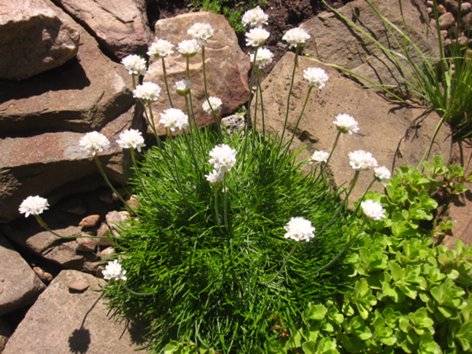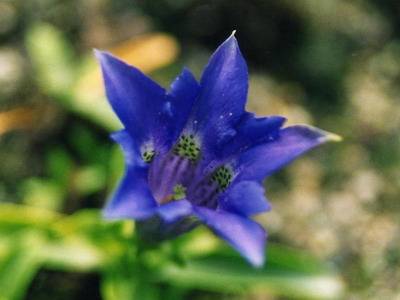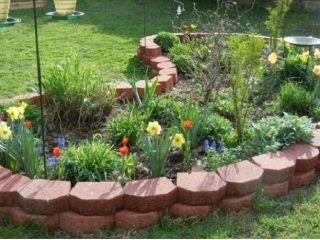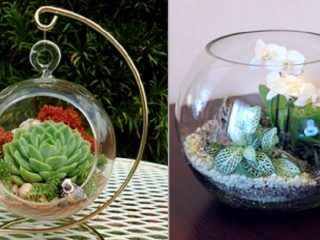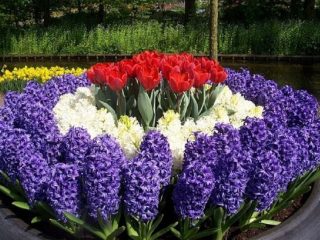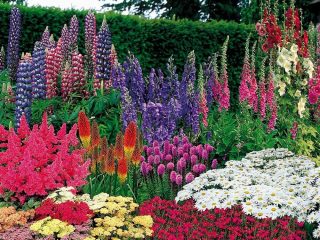Content
It is quite possible to create a beautiful flower bed that will bloom all summer long without much hassle if you select special varieties of perennials. They will not need to be planted every spring, wasting money and precious time. In landscape design, it is customary to combine tall and low perennials. Thus, more often than not, tall plants occupy a central place in the overall composition, while short plants flowers planted at the foot of the “green giants”.
Also, low-growing flowering plants can be used as an independent decorative element, decorating flower beds, lawns, and ponds. Choose short ones perennial flowers with a long flowering period is quite difficult for a non-professional, so in the article we present the most relevant, diverse varieties that meet the specified requirements.
Decorative linen
Anyone who has ever seen a field of blooming flax was probably impressed by this beauty: the blue expanses resemble the surface of the sea, into which you involuntarily want to plunge. Today, every gardener can create something similar in his own yard thanks to decorative flax.There are more than 100 perennial species of this wonderful plant. At the same time, the color of flowers, depending on the variety, can be diverse.
Alpine flax
The perennial plant has lanceolate leaves. The “Alpine” flower is pale blue, the inflorescence is simple. This variety is creeping, it can be planted on slopes, along borders, in flower beds, in combination with stone elements. The height of the spreading carpet does not exceed 20 cm.
Perennial low-growing “Austrian” flax is pleased with similar blue flowers. Its height does not exceed 30 cm.
Flax yellow
The yellow color of the flowers is not traditional for flax, however, among ornamental species such plants are quite common. These include “bell-shaped flax”, “capitate flax”, “yellow flax”.
For example, “Yellow Flax,” a photograph of which can be seen above, has umbrella-shaped flowers up to 2 cm in diameter. Their color is golden yellow. The height of the ornamental plant does not exceed 40 cm.
“Cell-shaped flax” can be considered unique, since its flowers are more closed compared to other types of decorative flax. They truly live up to the name and resemble small yellow bells. See a photo of this perennial possible below.
Blue varieties
In a wide variety of decorative flax, you can find varieties with a blue flower color, for example, “Flax of Narbonne” or “Rough-haired Flax.” These are low-growing plants, not exceeding 40 cm in height. The flowers of “Narbonne” flax are quite large, their diameter is 3-4 cm.
Blue and blue varieties of decorative flax must be grown in sunny areas of the land.The culture prefers moist, homogeneous nutrient soils. During the cultivation process, plants must be regularly watered and fed with mineral and organic fertilizers. Perennial varieties are resistant to severe and prolonged frosts. They do not need to be dug up or covered for the winter.
The following varieties of low-growing perennials actually bloom all summer: from June to September. During the flowering period, the thin stems of decorative flax are abundantly strewn with flowers. All varieties of flax, except creeping ones, must be tied to a support or sown densely enough to obtain a dense, stable bush.
Thrift
A beautiful perennial plant whose flowers captivate with their brightness and grace. You can meet Armeria growing wild in the vastness of Siberia, Mongolia, and America. Flower growers prefer to grow decorative varieties in their gardens.
Armeria alpine
Armeria alpine is a type of ornamental plant that includes several varieties: “Alba”, “Rosea”, “Laucheana”. The species is characterized by long (12-15 cm), sword-shaped leaves, only 0.3 cm wide. The peduncles of these plants are low-growing 20-30 cm. At their top you can see capitate, axillary inflorescences of various colors, depending on the variety. Armeria alpine blooms from June to August. Plants are resistant to lack of water and light.
In the above photograph you can see an example of the design of a landscape design element using the alpine variety “Alba”, the flowers of which are painted white.
Armeria variety "Rosea" is unique for its carmine-pink color of flowers. You can see the inflorescences of this plant in the photo below.
The flowers of the Laucheana variety are carmine-red in color.You can see an example of the use of this variety in landscape design in the photo:
Armeria seaside
Coastal army can be found in the mountains, on sea coasts and rocky areas. The leaves of this plant are short, up to 8 cm long, thin. The peduncles, rising 10-12 cm above the dense green cap, hold spherical flowers of lilac-pink color. Armeria maritime blooms from May to August. Sometimes you can see it bloom again in the fall.
In addition to the above, there are other types of Armeria, for example, Siberian Armeria, pseudo-Armeria, beautiful Armeria and some others. All these types of flowering herbaceous plants are low-growing, perennial. Their flowers, depending on the specific variety, are colored in different tones: from pink to lilac.
Armeria can be grown on any type of soil, however, the best soil for it is sandy loam. The plant is sown with seeds before winter or in spring. The culture is unpretentious and can successfully withstand heat and drought. For the winter, plants should be covered with spruce branches. Armeria must be divided and replanted every 2-3 years.
Pansies
Pansies are one of the most beautiful flowering plants. It is low-growing, perennial and not at all whimsical, but at the same time it gives a lot of aesthetic pleasure. The variety of varieties with different flower colors is amazing. Looking at Pansies, you understand that all the most beautiful things in this world are created by nature itself.
Small-flowered varieties
All those flowers that the average person calls pansies are called multi-flowered violets by breeders and are divided into species.Thus, there are small-flowered, large-flowered, and gigantic varieties. Among the small-flowered varieties there are plants with straightened petals and a familiar flower color. These include varieties "Snow Maiden", "Little Red Riding Hood", "Universal" and some others. So, the wonderful flowers of the “Little Red Riding Hood” variety can be seen below:
Of the small-flowered species, it is worth highlighting the variety “Rococo”. Its flowers have heavily frilled, double petals. The crop is low-growing, up to 20 cm high. The diameter of the flowers is 3-4 cm. These wonderful, amazing pansies can be planted in flower beds in combination with other tall and short plants. Photos of lilac and yellow-brown flowers of the variety "Rococo" are shown below.
The variety also has a bizarre flower shape "Flamenco". Its petals are partially ruffled and resemble the undulations of the full skirt in the famous dance of the same name. The name and photo of this variety allow you to personally evaluate the described correspondence.
Among the small-flowered varieties you can find pansies of various colors. The only thing they all have in common is the small diameter of the flower (no more than 4 cm). The peduncle of these varieties is quite long - 20 cm. These varieties are unpretentious in cultivation and are prone to self-propagation by involuntary sowing of mature seeds.
Large-flowered varieties
The very name “large-flowered” speaks about the peculiarity of this group of flowers. Varieties belonging to this species have a flower with a diameter of at least 5 cm. An example of such flowering plants are varieties "Ice King", "Winter Sun", "Sky Queen", "March Magic" and some others.
One of the large-flowered varieties is “Evening Heat”.These plants have a flower that is brownish-red in color. On its three upper petals there are spots of excellent color. The diameter of the flowers of this variety is 5.5-6 cm, the length of the peduncle is 9-10 cm. The total height of the bush is 10-15 cm.
Gigantic varieties
Pansies, which belong to the “giant” species, have very large flowers, the diameter of which is at least 7 cm. The bushes of such plants are massive, taking into account the peduncle, their height can reach 25 cm. It is worth noting that all “giant” varieties have a bright, but relatively uniform color. So, they highlight "White", "Blue", "Golden-yellow" varieties.
Eg "Blue" Pansies can be seen in the photo below. These flowers are blue in color, with deep purple spots located closer to the core. The edges of the petals are smooth. The length of the peduncle is 10-11 cm, the total height of the bush is 25 cm.
Pansy seeds can be sown in open ground until the end of June, however, with such sowing, the flowers will delight the eye only next year. In this case, it is much more convenient to grow seedlings of these plants. Sowing seeds for seedlings can be done in February-March, planting the plants in open ground in May. Culture drought tolerant, undemanding to soil nutrition. However, in order for pansies to delight with their beautiful large flowers for a long time, the plants need to be periodically fed with mineral fertilizers before and during flowering. Optimal watering frequency: 3-4 times a week.
With proper care, pansies will surprise with their beauty from June to September. For the winter, the bushes must be pruned and covered with spruce branches.
More detailed information on how to properly grow pansies is given in the video:
Gentian
Gentian is a genus of herbaceous, flowering plants. More than 90 varieties of these perennials can be grown in Russia. In nature, they are more often found in forests and parks. In landscape design, they are used to decorate flower beds, borders, walkways, and compositions using stone.
Gentian is often considered capricious, but in fact, only the composition of the soil in which it grows is very important for it. The soil should be as nutritious as possible with a high organic content. The plant is drought tolerant. It is better to plant flowers in the shade, since direct sunlight can destroy them.
Varieties of gentian are divided into several types, depending on the shape of the flower and the tallness of the plant. Thus, the shortest varieties belong to the species “Stemless Gentian”.
Hohenstein
This variety of gentian is one of the most popular. They decorate flower beds located in the shade of the garden. The plant is short, only 20 cm high. Its leaves are small, entire, and squat. The peduncle of such plants is practically absent. The flower itself is bell-shaped and colored azure blue.
The gentian variety “Rannoch” has a similar blue color and a similar shape of flowers, which can be seen below.
Chinese gentian
Chinese gentian is distinguished by the presence of pronounced light stripes on the calyx of the flower. Its main color is pale blue. The plant is low-growing, no more than 20 cm high, great for decorating lawns, flower beds, and front gardens.
Almost all low-growing gentian varieties have blue or light purple flowers. They are grown by sowing seeds.This perennial blooms from mid-summer to late autumn. The plant has a long, powerful root that goes deep into the ground, so you need to water the gentian abundantly. Plants older than 3 years cannot be replanted, as they will probably not take root. In nature, flowers of this unique variety can grow in one place for 60 years. Gentian blooms from mid-summer to late autumn. The fruits of this plant are seed pods.
Daisies
Speaking of low-growing perennials, it is necessary to mention daisies. These beautiful plants are represented by a large number of different varieties and can delight with their beauty throughout the summer. Daisies bloom in early spring as soon as the snow melts and continue to bloom throughout the summer season. A short break in flowering can only be observed in mid-summer, when critically hot weather sets in.
It is quite difficult to navigate the wide variety of daisies, so to simplify the choice, you can classify all varieties according to the shape of the flower (regular or spherical) and its color.
Thus, ordinary white flowers are characteristic of the varieties “Schneebal”, “Snowy Spring”, “Speedstar White”. A photo of the flowers of the latter variety is shown below.
The height of these low-growing plants does not exceed 12 cm. The diameter of the radiant, white, large flower is 6 cm.
Habanera Series daisies have white flowers with red tips. The diameter of these flowers is 6 cm, the height of the plants is from 15 to 20 cm.
When choosing daisies with a spherical flower shape, you should pay attention to the “Tasso” varieties. Their flowers can be white, pink or red.
Daisies are very loved by many gardeners because they are very unpretentious to the composition of the soil and can grow in the sun and in partial shade. The crop propagates by sowing seeds. The plants are frost-resistant and do not require shelter or preparation for the winter season. These wonderful flowers can be used to frame flower beds and borders. Some aesthetes plant daisies in pots, decorating loggias, balconies, and window sills with them.
Conclusion
White, yellow, red, blue and other shades of low-growing flowers can be combined with each other or combined with tall perennials. With their help you can create beautiful flower beds, lawns, and compositions using stone. In landscape design, it is important to set a goal and clearly imagine your idea, and then you will probably find planting material to realize the idea, because there are a huge number of different varieties of these wonderful plants. Using perennial plants in your landscape projects, man-made beauty will delight you every year throughout the summer season.





